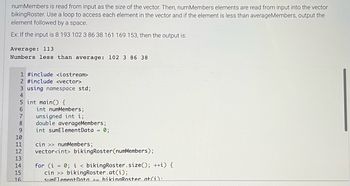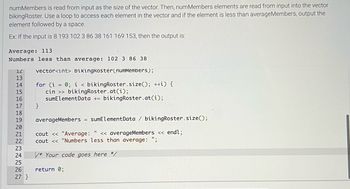
Computer Networking: A Top-Down Approach (7th Edition)
7th Edition
ISBN: 9780133594140
Author: James Kurose, Keith Ross
Publisher: PEARSON
expand_more
expand_more
format_list_bulleted
Question

Transcribed Image Text:numMembers is read from input as the size of the vector. Then, numMembers elements are read from input into the vector
bikingRoster. Use a loop to access each element in the vector and if the element is less than averageMembers, output the
element followed by a space.
Ex: If the input is 8 193 102 3 86 38 161 169 153, then the output is:
Average: 113
Numbers less than average: 102 3 86 38
1 #include <iostream>
2 #include <vector>
3 using namespace std;
4
5 int main() {
6
7
unsigned int i;
8 double averageMembers;
9
int sumElementData = 0;
10
11
12
13
14
15
16
int numMembers;
cin >> numMembers;
vector<int> bikingRoster (numMembers);
for (i = 0; i < bikingRoster.size(); ++i) {
cin >> bikingRoster.at(i);
sumElement Data + bikingRoster at(i):

Transcribed Image Text:numMembers is read from input as the size of the vector. Then, numMembers elements are read from input into the vector
bikingRoster. Use a loop to access each element in the vector and if the element is less than averageMembers, output the
element followed by a space.
Ex: If the input is 8 193 102 3 86 38 161 169 153, then the output is:
Average: 113
Numbers less than average: 102 3 86 38
vector<int> bikingkoster(numMembers);
12
13
14
15
16
17
18
19
20
21
22
~22222
23
24
25
26
27 }
for (i = 0; i < bikingRoster.size(); ++i) {
cin >> bikingRoster.at(i);
sumElementData + bikingRoster.at(i);
}
averageMembers = sumElement Data / bikingRoster.size();
cout << "Average: " << averageMembers << endl;
cout << "Numbers less than average: ";
* Your code goes here */
return 0;
Expert Solution
This question has been solved!
Explore an expertly crafted, step-by-step solution for a thorough understanding of key concepts.
This is a popular solution
Trending nowThis is a popular solution!
Step by stepSolved in 4 steps with 4 images

Knowledge Booster
Similar questions
- Finding the Minimum of a Vector Write a function to return the index of the minimum value in a vector, or -1 if the vector doesn't have any elements. In this problem you will implement the IndexOfMinimumElement function in minimum.cc and then call that function from main.cc. You do not need to edit minimum.h. Index of minimum value with std::vector Complete IndexOfMinimumElement in minimum.cc. This function takes a std::vector containing doubles as input and should return the index of the smallest value in the vector, or -1 if there are no elements. Complete main.cc Your main function asks the user how many elements they want, construct a vector, then prompts the user for each element and fills in the vector with values. Your only task in main is to call the IndexOfMinimumElement function declared in minimum.h, and print out the minimum element's index. Here's an example of how this might look: How many elements? 3 Element 0: 7 Element 1: -4 Element 2: 2 The minimum value in your…arrow_forwardSelect all code lines that creates a vector with content {10, 10, 10, 10). You are also given the C-type array, an_array with content (10, 10, 10, 10). std::vector a_vector (an_array, an_array + sizeof(an_array)/sizeof(int)); std::vector a_vector [10, 10, 10, 10); std::vector a_vector (10, 4); std::vector a_vector = {10, 10, 10, 10); Ostd::vector a_vector (4, 10);arrow_forwardPrompt: In Python language, write a function that applies the logistic sigmoid function to all elements of a NumPy array. Code: import numpy as np import math import matplotlib.pyplot as plt import pandas as pd def sigmoid(inputArray): modifiedArray = np.zeros(len(inputArray)) #YOUR CODE HERE: return(modifiedArray) def test(): inputs = np.arange(-100, 100, 0.5) outputs = sigmoid(inputs) plt.figure(1) plt.plot(inputs) plt.title('Input') plt.xlabel('Index') plt.ylabel('Value') plt.show() plt.figure(2) plt.plot(outputs,'Black') plt.title('Output') plt.xlabel('Index') plt.ylabel('Value') plt.show() test()arrow_forward
- ASSIGNMENT: Working with Vectors Write a menu-driven program that will allow the user to run any of the following questions. Please put the functions headers in h file and the functions definitions in a .cpp file. 1. Write C++ code for a loop that simultaneously computes both the maximum and minimum element in a given vector. 2. Write a function double scalar_product(vector a, vector b) that computes the scalar product of two vectors. The scalar product of two vectors A[al, a2, a3) and B(bl, b2, b3} is another vector C given by C{c1, c2, c3} where cl = al * b1, c2 = a2 + b2, c3 = a3 + b3. 3. Write a function that computes the alternating sum of all elements in a vector. For example, if alternatingSum() is called with a vector containing 149 16 9 7 4 9 11 then it computes 1-4+9-16+9-7+4-9+11=-2 4. Write a procedure reverse that reverses the sequence of elements in a vector. For example, if reverse is called with a vector containing 1 49 16 9 7 4 9 11 then the vector is changed 11 9 4 7…arrow_forwardIn c++ i have this information Type of Ticket &. Cost Monday. Adult= £25 and Child = £15 Thursday. Adult = £40 and child = £20 I have made a vector to store this information Vectorticket ={“Monday”, “Thursday”}; Vectoradult = {25, 40}; Vectorchildren ={15, 20}; Thr format of the adult and children vectors is in the order such that the first elements in those vectors correspond with the first element in the ticket vector Now what am struggling with, is i want the program to calculate the total cost of the tickets in correspondant with The user’s inputs which will be the quantity of how many tickets the user bought respectively (adult and children) So something like Monday 1 2 So 1 will be quantity of adult ticket and 2 will quantity of children ticket and the total costs of both added togetherarrow_forwardComplete the following function that counts the even numbers in a 2D vector of integers. int count_evens(const std::vector<std::vector<int>>& v) { // Add your code... } Please add output screenshot!arrow_forward
- Use iterators to print each element of v separted by spaces. #include <iostream>#include <vector> using namespace std; int main(){vector<int> v = {1, 3, 5}; (.....) }arrow_forwardIntegers are read from input and stored into a vector until 0 is read. If the vector's last element is odd, output the odd elements in the vector. Otherwise, output the even elements in the vector. End each number with a newline. Ex: If the input is -9 12 -6 1 0, the vector's last element is 1. Thus, the output is: -9 1 Note: (x % 2 != 0) returns true if x is odd. int value; int i; bool isodd; 7 8 9 10 11 12 13 14 15 16 17 18 19 20 21 22 23 } cin >> value; while (value != 0) { } for (i = 0; i > value; Check return 0; 1 Next level 2 X 1: Compare output 3 4 For input -9 12 -6 1 0, the vector elements are -9, 12, -6, and 1. The last element, 1, is odd. The odd elements in the vector, -9 and 1, are output, each on a new line. Not all tests passed. 2 V 3arrow_forwardIntegers are read from input and stored into a vector until 0 is read. If the vector's last element is odd, output the odd elements in the vector. Otherwise, output the even elements in the vector. End each number with a newline. Ex: If the input is -9 12 -6 1 0, the vector's last element is 1. Thus, the output is: -9 1 Note: (x % 2!= 0) returns true if x is odd. 4 5 int main() { 6 7 8 9 10 11 12 13 14 15 16 17 18 19 20} vector vect1; int value; int i; bool isodd; cin >> value; while (value != 0) { vect1.push_back(value); cin >> value; } V* Your code goes here */ return 0; 2 3arrow_forward
- import numpy as np import torch import matplotlib.pyplot as plt Quiz Preparation Question 1. Write a function that generates a random tensor of n x n (n is the input). The output is the mean of the tensor. = 2, 4, 8, 16, ... 1024 and generate a vector 2. Write a code (for loop) that call that calls the function above with n = M(n). Plot the vector as a function of the log of n. 3. Given an n x m array write a code that replaces every element that is larger than 0.5 with 0.5. 4. The second derivative of a function can be approximated by the finite difference 1 ƒ"(x₂) = 73 (ƒ(£;+1) — 2ƒ(x;) + f(x;-1)) Given a vector f with values f = [f(xo),..., f(n) write a code that computes the approximation to f"(x) 5. The power method is a method to compute the largest eigenvalue of a matrix. Your google search is using this method every time you perform a google search. The method consists of the iteration Vj+1 = Av; || Avi|| where v; is a vector with chosen as a random vector, and A is the matrix…arrow_forwardTradng SelCLOon Write the state of the elements of the vector below after each of the first 3 passes of the outermost loop of the selection sort algorithrm // index 0 1 2 3 4 5 6 7 Vector numbers = {29, 17, 3, 94, 46, 8, -4, 12}; selectionSort(numbers); For example, if the vector was {(43125), you would write: {4 3 1 2 5} {1 3 4 2 5} (1 2 4 3 5} {1 2 3 4 5} Thought: How many vectors would I need here if I were to implement this in code? Write your answer here. hparrow_forward
arrow_back_ios
arrow_forward_ios
Recommended textbooks for you
 Computer Networking: A Top-Down Approach (7th Edi...Computer EngineeringISBN:9780133594140Author:James Kurose, Keith RossPublisher:PEARSON
Computer Networking: A Top-Down Approach (7th Edi...Computer EngineeringISBN:9780133594140Author:James Kurose, Keith RossPublisher:PEARSON Computer Organization and Design MIPS Edition, Fi...Computer EngineeringISBN:9780124077263Author:David A. Patterson, John L. HennessyPublisher:Elsevier Science
Computer Organization and Design MIPS Edition, Fi...Computer EngineeringISBN:9780124077263Author:David A. Patterson, John L. HennessyPublisher:Elsevier Science Network+ Guide to Networks (MindTap Course List)Computer EngineeringISBN:9781337569330Author:Jill West, Tamara Dean, Jean AndrewsPublisher:Cengage Learning
Network+ Guide to Networks (MindTap Course List)Computer EngineeringISBN:9781337569330Author:Jill West, Tamara Dean, Jean AndrewsPublisher:Cengage Learning Concepts of Database ManagementComputer EngineeringISBN:9781337093422Author:Joy L. Starks, Philip J. Pratt, Mary Z. LastPublisher:Cengage Learning
Concepts of Database ManagementComputer EngineeringISBN:9781337093422Author:Joy L. Starks, Philip J. Pratt, Mary Z. LastPublisher:Cengage Learning Prelude to ProgrammingComputer EngineeringISBN:9780133750423Author:VENIT, StewartPublisher:Pearson Education
Prelude to ProgrammingComputer EngineeringISBN:9780133750423Author:VENIT, StewartPublisher:Pearson Education Sc Business Data Communications and Networking, T...Computer EngineeringISBN:9781119368830Author:FITZGERALDPublisher:WILEY
Sc Business Data Communications and Networking, T...Computer EngineeringISBN:9781119368830Author:FITZGERALDPublisher:WILEY

Computer Networking: A Top-Down Approach (7th Edi...
Computer Engineering
ISBN:9780133594140
Author:James Kurose, Keith Ross
Publisher:PEARSON

Computer Organization and Design MIPS Edition, Fi...
Computer Engineering
ISBN:9780124077263
Author:David A. Patterson, John L. Hennessy
Publisher:Elsevier Science

Network+ Guide to Networks (MindTap Course List)
Computer Engineering
ISBN:9781337569330
Author:Jill West, Tamara Dean, Jean Andrews
Publisher:Cengage Learning

Concepts of Database Management
Computer Engineering
ISBN:9781337093422
Author:Joy L. Starks, Philip J. Pratt, Mary Z. Last
Publisher:Cengage Learning

Prelude to Programming
Computer Engineering
ISBN:9780133750423
Author:VENIT, Stewart
Publisher:Pearson Education

Sc Business Data Communications and Networking, T...
Computer Engineering
ISBN:9781119368830
Author:FITZGERALD
Publisher:WILEY